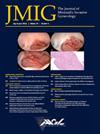HIFU 与手术治疗直肠子宫内膜异位症的评估:双中心回顾性比较研究
IF 3.5
2区 医学
Q1 OBSTETRICS & GYNECOLOGY
引用次数: 0
摘要
研究目的比较直肠子宫内膜异位症HIFU治疗和手术治疗6个月后的症状以及治疗相关的发病率.设计在2个子宫内膜异位症参考中心进行的比较性回顾性双中心研究.设置患者在手术室麻醉下进行HIFU手术或腹腔镜切除术.患者或参与者120例患者(包括每组60例患者)接受治疗并随访6个月.干预措施直肠HIFU治疗与直肠子宫内膜异位症结节腹腔镜手术。测量和主要结果患者在接受治疗前通过问卷对症状进行评估,6个月后再次通过问卷对症状进行评估:妇科和消化系统症状(VAS)、健康状况(MOSSF-36)、大便失禁(WEXNER)、便秘(KESS)和整体性健康(FSFI)。我们还根据 Clavien-Dindo 分类法评估了两种治疗方法的发病率。120 名患者接受了 HIFU 或直肠手术治疗,每组 60 人。两组患者的直肠结节特征相当。在 HIFU 组和手术组中,克拉维恩-丁度 2 级和 3 级并发症发生率分别为 3.3% 对 21.7%(P=0.002)和 0% 对 10%(P=0.01)。HIFU 组的住院时间也明显缩短(1 天 vs. 3 天,p<0.001)。在 HIFU 组,急性盆腔疼痛/痛经、排便困难、腹泻、直肠痉挛、排便时疼痛和尿急等症状均有明显改善。在手术组中,急性盆腔疼痛/痛经、腹泻、直肠痉挛和排便时疼痛均有显著改善。两组患者的 FSFI、KESS 和 WEXNER 评分以及 6 个月后的健康状况均有所改善。结论 HIFU 治疗可显著降低术后并发症的风险,同时至少可获得相似的症状和生活质量,适合患者作为手术治疗的替代方案。长期并发症和复发风险需要进一步研究。本文章由计算机程序翻译,如有差异,请以英文原文为准。
Evaluation of Rectal Endometriosis Treatment With HIFU Versus Surgery: A Comparative Retrospective Bicentric Study
Study Objective
Comparing rectal endometriosis treatment with HIFU and surgery in terms of symptoms at 6 months and treatments-related morbidity.
Design
Comparative retrospective, bicentric study in 2 endometriosis reference centers.
Setting
Patients operated by HIFU or laparoscopic resection in the operating room under anesthesia.
Patients or Participants
120 patients, including 60 patients in each arm, were treated and followed for 6 months.
Interventions
Endo-rectal HIFU treatment versus laparoscopic surgery of rectal endometriosis nodule.
Measurements and Main Results
Patients’ symptomatology was assessed with questionnaires prior to receiving treatment then again 6 months later using questionnaires: gynecological and digestive symptoms (VAS), health status (MOSSF-36), fecal incontinence (WEXNER), constipation (KESS) and overall sexual health (FSFI). We also assessed the morbidity of both treatments according to the Clavien-Dindo classification. 120 patients, 60 in each group, received HIFU or rectal surgery. Rectal nodules characteristics were comparable in both groups. In the HIFU and surgery groups, Clavien-Dindo grade 2 and 3 complication rates were respectively 3.3% vs. 21.7% (p=0.002) and 0% vs. 10% (p=0.01). Hospitalization duration was also significantly shorter for HIFU group (1 day vs. 3 days, p<0.001). In the HIFU group, significative improvement was observed in acute pelvic pain/dysmenorrhea, dyspareunia, diarrhea, rectal spasms, pain during bowel movement and urinary urgency. In the surgical arm, significative improvement was observed in acute pelvic pain/dysmenorrhea, diarrhea, rectal spasms and pain during bowel movement. In both groups, we can witness an improvement in FSFI, KESS and WEXNER scores and health status at 6 months.
Conclusion
HIFU treatment enables significant reduction in the risk of postoperative complications while allowing at least similar symptoms and quality of life outcomes and could be used as an alternative to surgical treatment for suitable patients. Long-term complications and relapse risks require further research.
求助全文
通过发布文献求助,成功后即可免费获取论文全文。
去求助
来源期刊
CiteScore
5.00
自引率
7.30%
发文量
272
审稿时长
37 days
期刊介绍:
The Journal of Minimally Invasive Gynecology, formerly titled The Journal of the American Association of Gynecologic Laparoscopists, is an international clinical forum for the exchange and dissemination of ideas, findings and techniques relevant to gynecologic endoscopy and other minimally invasive procedures. The Journal, which presents research, clinical opinions and case reports from the brightest minds in gynecologic surgery, is an authoritative source informing practicing physicians of the latest, cutting-edge developments occurring in this emerging field.

 求助内容:
求助内容: 应助结果提醒方式:
应助结果提醒方式:


